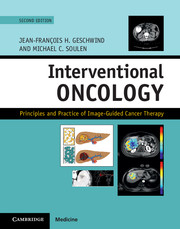Book contents
- Frontmatter
- Contents
- List of contributors
- Section I Principles of oncology
- Section II Principles of image-guided therapies
- 2 Principles of radiofrequency and microwave tumor ablation
- 3 Principles of irreversible electroporation
- 4 Principles of high-intensity focused ultrasound
- 5 Principles of tumor embolotherapy and chemoembolization
- 6 Principles of radioembolization
- 7 Principles of intra-arterial infusional chemotherapy in the treatment of liver metastases from colorectal cancer
- 8 Imaging in interventional oncology: Role of image guidance
- 9 Novel developments in MR assessment of treatment response after locoregional therapy
- Section III Organ-specific cancers – primary liver cancers
- Section IV Organ-specific cancers – liver metastases
- Section V Organ-specific cancers – extrahepatic biliary cancer
- Section VI Organ-specific cancers – renal cell carcinoma
- Section VII Organ-specific cancers – chest
- Section VIII Organ-specific cancers – musculoskeletal
- Section IX Organ-specific cancers – prostate
- Section X Specialized interventional techniques in cancer care
- Index
- References
7 - Principles of intra-arterial infusional chemotherapy in the treatment of liver metastases from colorectal cancer
from Section II - Principles of image-guided therapies
Published online by Cambridge University Press: 05 September 2016
- Frontmatter
- Contents
- List of contributors
- Section I Principles of oncology
- Section II Principles of image-guided therapies
- 2 Principles of radiofrequency and microwave tumor ablation
- 3 Principles of irreversible electroporation
- 4 Principles of high-intensity focused ultrasound
- 5 Principles of tumor embolotherapy and chemoembolization
- 6 Principles of radioembolization
- 7 Principles of intra-arterial infusional chemotherapy in the treatment of liver metastases from colorectal cancer
- 8 Imaging in interventional oncology: Role of image guidance
- 9 Novel developments in MR assessment of treatment response after locoregional therapy
- Section III Organ-specific cancers – primary liver cancers
- Section IV Organ-specific cancers – liver metastases
- Section V Organ-specific cancers – extrahepatic biliary cancer
- Section VI Organ-specific cancers – renal cell carcinoma
- Section VII Organ-specific cancers – chest
- Section VIII Organ-specific cancers – musculoskeletal
- Section IX Organ-specific cancers – prostate
- Section X Specialized interventional techniques in cancer care
- Index
- References
Summary
Background
The rationale for regional chemotherapy is to maximize drug concentrations and tumor drug uptake in the target organ and minimize systemic toxicity. For regional drug delivery to successfully impact relevant outcomes, several important principles regarding tumor biology, drug pharmacology, and delivery systems must be fulfilled. The model of liver metastasis from colorectal cancer complies with these principles, as colorectal cancer has a regional pattern of dissemination, with the liver being the only site of metastatic disease for long periods of time in some cases. Other salient features include the selective supply of blood to liver metastases by the hepatic artery and availability of active drugs with suitable pharmacokinetic properties.
In this chapter, pharmacological concepts of regional therapy will be reviewed. Desirable pharmacokinetic and pharmacodynamic characteristics of drugs considered for evaluation in the hepatic arterial infusion (HAI) model of regional drug delivery will be discussed, using floxuridine (FUDR) as a model, in the context of patients with colorectal liver-only metastases (CRLM). Also, an evaluation of the pharmacology of currently approved agents for the treatment of metastatic colon cancer and their hypothetical value for regional drug delivery will be performed. Results of phase I and phase II trials of HAI with these drugs, if available, will be explained in terms of the previously established pharmacologic rationale. Finally, for active drugs not already tested, a critical analysis will be done of the available pharmacokinetics data to determine the likelihood of successful incorporation of these drugs to HAI-based therapeutics. We provide an appendix with basic pharmacology definitions to enhance comprehension for the reader who is not familiar with these concepts.
Pharmacologic concepts useful in understanding and evaluating potential advantages of regional delivery for specific drugs
The ultimate goal of regional therapy is to improve the therapeutic index by increasing efficacy and decreasing systemic toxicity. Hepatic arterial therapy relies on two important assumptions:
1. Regional delivery of the drug leads to increased local concentration and therefore increased therapeutic response.
2. Regional delivery of the drug leads to decreased systemic exposure and reduced systemic toxicity.
The suitability of any specific drug for regional therapy can be evaluated by the extent to which it fulfills these assumptions.
- Type
- Chapter
- Information
- Interventional OncologyPrinciples and Practice of Image-Guided Cancer Therapy, pp. 52 - 64Publisher: Cambridge University PressPrint publication year: 2016



